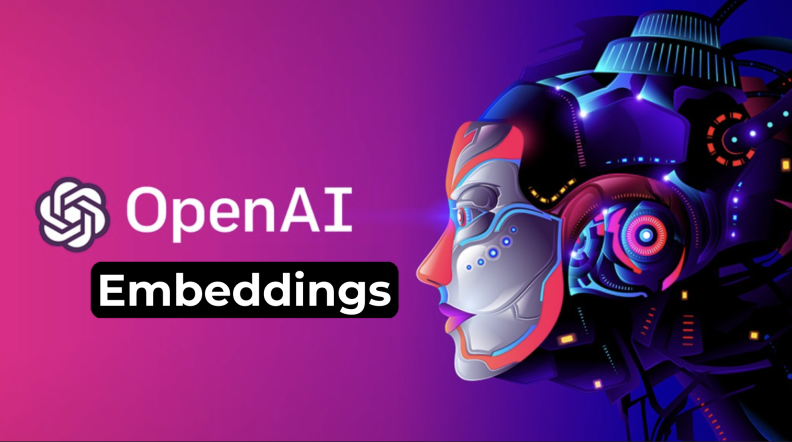Unlocking the Power of OpenAI Embeddings: A Comprehensive Guide






OpenAI embeddings unlock a world of possibilities in understanding and processing language and code. By converting complex information into a format that machines can understand, these embeddings enable a deeper connection between human knowledge and machine learning models and algorithms. This guide aims to explore the intricacies and applications of OpenAI’s embedding technology, offering insights into how they can be leveraged for innovative solutions.
An Overview of OpenAI Embeddings
At the heart of machine learning and natural language processing lies the concept of embeddings. An embedding is a vector representation of data, transforming inputs in the original format into vectors in a space where distance between two embeddings reflects their semantic similarity. OpenAI’s embeddings, built upon advanced machine learning models and algorithms, excel in capturing the essence of textual and code-based information, setting a new standard in the format of data representation.
Introduction to Embedding Models
Natural language and code snippets embody complex ideas that challenge traditional computational analysis. OpenAI embedding models, including Azure OpenAI Embedding, serve as bridges, turning pieces of text and code into comprehensive vectors. These models facilitate an understanding that aligns closely with human intuition, enabling machines to grasp the subtleties of language and code with remarkable accuracy.
The Evolution of OpenAI’s Embedding Technology
From its inception, OpenAI has focused on refining text embeddings to capture the nuances of language more effectively. This evolution reflects a commitment to deepening the machine’s understanding of natural language, ensuring that each iteration of technology brings us closer to a future where machines can comprehend and interact with human language in all its complexity.
Key Features and Benefits of Using OpenAI Embeddings
OpenAI embeddings stand out for their ability to transform abstract textual and code information into tangible vector representations. This transformation paves the way for enhanced machine understanding, enabling applications ranging from semantic search to automated content generation. The versatility and depth of these embeddings make them invaluable tools in the advancement of machine learning and artificial intelligence.
Delving into Specific Models and Updates
The landscape of OpenAI’s embedding technology is constantly evolving, with new models and updates designed to enhance performance and expand capabilities. These advancements focus on improving the accuracy and efficiency of text and code embeddings, ensuring that users have access to the most cutting-edge tools for their machine learning and natural language processing needs.
The Latest in Text and Code Embedding Models
OpenAI’s commitment to innovation is evident in its latest text and code embeddings. These models, built on the foundation of OpenAI’s embeddings, are fine-tuned to offer unparalleled precision in understanding and generating language and code. The introduction of these models marks a significant milestone in the journey toward more intelligent and responsive AI systems.
Text Similarity Models and Their Applications
Text similarity models have revolutionized the way we identify and compare documents, facilitating a range of applications from plagiarism detection to content recommendation systems. By analyzing the semantic similarity between two inputs, these models offer insights that go beyond surface-level comparisons, uncovering the deeper meaning and context of the text.
Code Search Models Across Various Programming Languages
The OpenAI API has ushered in a new era of code search, enabling developers to find relevant code snippets across various programming languages with ease. This breakthrough enhances productivity and fosters a more collaborative environment by simplifying the process of code reuse and adaptation.
Breakthroughs in Embedding Shortening Techniques
The latest OpenAI advancements include significant breakthroughs in embedding shortening techniques. These techniques, supported by vector stores, optimize storage without compromising the quality of embeddings. This innovation represents a leap forward in making embedding technology more accessible and efficient.
Native Support for Shortening Embeddings: A Closer Look
Delving deeper into the latest OpenAI update, native support for shortening embeddings offers a glimpse into the future of efficient data processing. By reducing the length of vectors while maintaining their integrity, these vector stores ensure that embeddings remain a practical and powerful tool for machine learning applications.
Practical Applications and Examples
OpenAI embeddings have found their place in a wide array of practical applications, proving their versatility and effectiveness in solving real-world problems. From enhancing search engines to facilitating code development, these embeddings are transforming industries by enabling a deeper understanding of natural language and code.
Examples of the Embeddings API in Action
The power of OpenAI’s text embeddings is showcased through the Embeddings API, which has been instrumental in developing innovative solutions across various sectors. Whether it’s improving search functionality or creating more engaging user experiences, the API demonstrates the practical benefits of embedding technology.
How Businesses Leverage Text-Embedding for Enhanced Search Capabilities
Businesses are leveraging text-embedding technology to revolutionize their search capabilities, offering users more accurate and relevant results. This application of OpenAI’s embeddings not only enhances user satisfaction but also drives efficiency, by understanding the semantic context of search queries.
Code Embeddings in Practice: Improving Code Search and Classification
Through the OpenAI API, code embeddings are making strides in improving code search and classification. By understanding the semantic meaning behind code snippets, these embeddings facilitate a more intuitive and streamlined development process, empowering developers to work more efficiently.
Embeddings in Academic Research
In the realm of academic research, OpenAI embeddings have sparked a revolution by offering new avenues for exploring complex language patterns and behaviors. These embeddings, or embedding vectors, serve as the foundation for advanced studies in natural language processing (NLP) and machine learning, enabling researchers to uncover deeper insights into how language is structured and understood by machines. By transforming words into numerical representations, embeddings have facilitated significant progress in language-related studies, pushing the boundaries of what’s possible in machine learning models and algorithms.
Contributions to Language Understanding and Machine Learning
OpenAI embeddings have significantly contributed to advancements in language understanding and machine learning by providing a more nuanced way to represent linguistic data. The embedding vectors, by capturing semantic similarities between words or phrases, have enabled researchers to achieve breakthroughs in various areas, including sentiment analysis, language translation, and text summarization. These contributions have not only enhanced the capabilities of machine learning models but have also paved the way for more sophisticated and human-like language processing technologies.
Managing and Understanding API Usage
Managing and understanding the usage of OpenAI’s API is crucial for developers and businesses aiming to integrate advanced NLP features into their solutions efficiently. By effectively overseeing API calls, users can optimize their operations, reduce costs, and ensure a seamless integration of OpenAI’s capabilities. This involves keeping track of usage metrics, understanding the limits and capabilities of the API, and employing strategies to maximize its potential without compromising on performance or accruing unnecessary expenses.
Tools for API Key Management and Usage Insights
To assist users in managing their API keys and gaining insights into their usage, OpenAI provides a suite of tools designed to streamline these processes. These tools enable users to monitor their API consumption, track the performance of their requests, and adjust their usage patterns as needed. By leveraging these tools, developers and businesses can maintain optimal control over their API usage, ensuring they are getting the most out of OpenAI’s embedding technologies while keeping their operations efficient and cost-effective.
Streamlining API Calls for Efficiency
Streamlining API calls is essential for maximizing the efficiency of integrating OpenAI embeddings into applications. By optimizing how and when API calls are made, users can significantly reduce latency, improve response times, and minimize the use of computational resources. This involves batching requests, caching results for frequently queried information, and carefully planning the architecture of the application to reduce redundant calls. Such measures not only enhance the performance of the application but also contribute to a more cost-effective use of the OpenAI API.
The Future of Embedding Models
The future of OpenAI embedding models looks promising, with ongoing advancements aimed at refining their accuracy and versatility. As these models evolve, they are expected to offer even more precise understanding and generation of text, code snippets, and other pieces of text. The integration of OpenAI embeddings with platforms like Azure OpenAI embedding suggests a trend towards more accessible, powerful, and customizable NLP solutions that cater to a wide range of applications, from automated content creation to sophisticated data analysis tasks.
Upcoming Models and Anticipated Improvements
Looking ahead to 2024, the anticipation for new and improved OpenAI embedding models is high. These future models are expected to bring about significant enhancements in terms of processing speed, accuracy, and the ability to understand and generate more complex language structures and code configurations. Such advancements will not only benefit current applications but will also open up new possibilities for leveraging NLP technologies in innovative ways, further bridging the gap between human and machine communication.
The Role of Community Feedback in Shaping Future Updates
Community feedback plays a crucial role in shaping the future updates of OpenAI embedding models. By actively engaging with users and developers, OpenAI can gather valuable insights and suggestions that inform the development of new features and improvements. This collaborative approach ensures that the evolving needs and challenges of the community are addressed, leading to embedding technologies that are more refined, user-friendly, and capable of driving forward the future of machine learning and NLP research.
Getting Started with OpenAI Embeddings
Getting started with OpenAI embeddings involves understanding the basics of machine learning models and algorithms, as well as the various formats of data representation. Embeddings transform inputs in the original format into vectors in a vector space, where the distance between two embeddings indicates their semantic similarity. This vector space is correlated with semantic similarity, allowing for sophisticated analyses and applications, such as vector similarity search in Azure databases. With tools like Azure SQL Database, developers can leverage these embeddings, composed of floating point numbers, to enhance search capabilities and data analysis.
Step-by-Step Guide to Implementing Embeddings in Your Projects
Implementing OpenAI embeddings in projects requires a structured approach, beginning with selecting the appropriate model for the task at hand. Developers must then prepare their data, ensuring it’s in a format compatible with the model’s requirements. Following data preparation, embedding vectors are generated and can be utilized for a variety of applications, from enhancing search functionalities to facilitating more accurate recommendations. Throughout this process, it’s crucial to evaluate the performance and adjust parameters as needed to optimize outcomes.
Resources for Developers and Researchers
For developers and researchers eager to dive deeper into OpenAI embeddings, a wealth of resources is available to support their endeavors. These include comprehensive documentation, tutorials, and community forums where individuals can exchange ideas, solve problems, and share insights. Additionally, academic papers and case studies provide valuable perspectives on the theoretical underpinnings and practical applications of embeddings, enriching the knowledge base for those looking to leverage these technologies in their projects.
A Glimpse into What’s Next for OpenAI Embeddings
The ongoing research and development efforts in OpenAI embeddings are set to push the boundaries of what’s possible in NLP and machine learning. With a focus on enhancing accuracy, reducing biases, and expanding the range of languages and domains these embeddings can comprehend, the future holds exciting prospects. Integration with technologies like Azure SQL Database, Azure Cosmos DB for NoSQL, and Azure AI further indicates a trend towards making these powerful tools more accessible and applicable across a broader spectrum of industries and applications.
Ongoing Research and Development Efforts
Ongoing research and development efforts are heavily focused on improving the effectiveness of OpenAI embeddings through advanced techniques like cosine similarity. By refining how embeddings calculate the similarity between vectors, these efforts aim to enhance the precision of language models in understanding and generating text. Continuous investment in R&D ensures that OpenAI embeddings remain at the forefront of NLP technology, offering state-of-the-art solutions for complex language and coding tasks.
How OpenAI Plans to Further Revolutionize Embedding Technologies
OpenAI is committed to revolutionizing embedding technologies by continuously exploring new methodologies and approaches to improve their performance and applicability. This includes developing more sophisticated algorithms that can accurately capture the nuances of language and code, expanding the scope of what these embeddings can achieve. By prioritizing innovation and responding to the evolving needs of users and developers, OpenAI aims to maintain its leadership in the field of NLP, driving forward the capabilities of machine learning and artificial intelligence.
Beyond the Basics: Advanced Insights into OpenAI Embeddings
For those looking to go beyond the basics, advanced insights into OpenAI embeddings offer a deeper understanding of how these technologies work and their potential impact on the future of computing. This includes exploring the intricacies of embedding algorithms and their optimization, as well as conducting comparative analyses against other NLP solutions. Such insights provide a comprehensive view of the state-of-the-art in embedding technologies, equipping users with the knowledge to innovate and push the boundaries of what’s possible in machine learning and artificial intelligence.
Deep Dive into Embedding Algorithms and Their Optimization
Embedding algorithms play a crucial role in understanding and processing natural language by transforming words into numerical representations. These algorithms are optimized to capture the essence of words, phrases, and even entire documents, enabling machines to grasp their meanings. Optimization techniques focus on enhancing the accuracy and efficiency of these embeddings, ensuring they accurately reflect the context and nuances of the language. This process involves sophisticated mathematical models that adjust and refine embeddings based on vast amounts of text data, leading to more effective and nuanced language understanding capabilities.
Comparative Analysis of OpenAI Embeddings Against Other NLP Solutions
When comparing OpenAI embeddings to other natural language processing (NLP) solutions, several key differences emerge. OpenAI’s embeddings are renowned for their depth and contextual understanding, offering nuanced interpretations of text that go beyond mere word associations. This is in contrast to some other NLP solutions that may rely on simpler, less context-aware methods. OpenAI’s approach allows for a more sophisticated understanding of language, leading to applications that can more accurately mimic human-like understanding. The continuous improvement and updates to OpenAI’s models also mean they remain at the forefront of NLP technology, often setting the benchmark for others in the field.
Navigating the World of OpenAI Embeddings: A Path Forward
As we explore the depths of OpenAI embeddings, understanding their core—numerical representations of concepts—becomes crucial. These embeddings, especially in tasks like clustering, thrive in their 3072 dimensions environment, allowing for a rich and nuanced understanding of data. The ability to shorten embeddings, pioneered by experts such as Arvind Neelakantan, Ted Sanders, and Ryan Greene, marks a significant advancement, making these models more accessible and efficient. The use of a Python library simplifies interaction with these technologies, ensuring that managing API keys and utilizing advanced RAG becomes an intuitive part of leveraging OpenAI embeddings models. This journey into the realm of OpenAI embeddings is not just about grasping the present but also about paving a path forward, where continuous learning and adaptation become key to unlocking even greater possibilities.